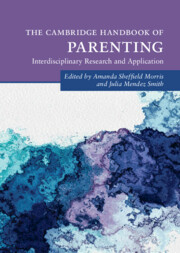Book contents
- The Cambridge Handbook of Parenting
- Cambridge Handbooks in Psychology
- The Cambridge Handbook of Parenting
- Copyright page
- Dedication
- Contents
- Contributors
- Figures
- Tables
- Introduction
- Part I Foundations of Parenting
- 1 Foundational Theories and the Establishment of Parenting Science Research
- 2 Parenting, Challenges, Brain Development, and Attachment Strategies
- 3 Parenting and Brain Development
- 4 Parenting and Children’s Social and Emotional Development: Emotion Socialization across Childhood and Adolescence
- 5 Parents Matter: The Cornerstone for Children’s Cognitive and Language Development
- 6 Discipline and Punishment in Child Development
- 7 Parenting From a Cultural and Global Perspective: A Review of Theoretical Models and Parenting Research in Diverse Cultural Contexts
- Part II Parenting across Development: Social, Emotional, and Cognitive Influences
- Part III Parental Factors That Impact Parenting
- Part IV Child Factors that Impact Parenting
- Part V Parent Education, Intervention and Policy
- Index
- References
3 - Parenting and Brain Development
from Part I - Foundations of Parenting
Published online by Cambridge University Press: 01 December 2022
- The Cambridge Handbook of Parenting
- Cambridge Handbooks in Psychology
- The Cambridge Handbook of Parenting
- Copyright page
- Dedication
- Contents
- Contributors
- Figures
- Tables
- Introduction
- Part I Foundations of Parenting
- 1 Foundational Theories and the Establishment of Parenting Science Research
- 2 Parenting, Challenges, Brain Development, and Attachment Strategies
- 3 Parenting and Brain Development
- 4 Parenting and Children’s Social and Emotional Development: Emotion Socialization across Childhood and Adolescence
- 5 Parents Matter: The Cornerstone for Children’s Cognitive and Language Development
- 6 Discipline and Punishment in Child Development
- 7 Parenting From a Cultural and Global Perspective: A Review of Theoretical Models and Parenting Research in Diverse Cultural Contexts
- Part II Parenting across Development: Social, Emotional, and Cognitive Influences
- Part III Parental Factors That Impact Parenting
- Part IV Child Factors that Impact Parenting
- Part V Parent Education, Intervention and Policy
- Index
- References
Summary
The quality of the caregiving environment is one of the most impactful elements on youth’s development, with evidence suggesting these experiences are embedded at the neural level. This chapter reviews empirical research characterizing relations between parenting and child and adolescent brain development with respect to a full continuum of maladaptive to adaptive parenting behavior. We consider evidence directly linking parental factors on neural indices of development, as well as growing evidence characterizing individual differences in neurobiological susceptibility to the caregiving environment. We conclude with a discussion of future directions for this research.
- Type
- Chapter
- Information
- The Cambridge Handbook of Parenting , pp. 50 - 70Publisher: Cambridge University PressPrint publication year: 2022
References
- 1
- Cited by

